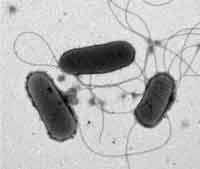Know Your Enemy: Escherichia coli, E.coli
By: Suzanne Osborne, Ph.D
Escherichia coli (E. coli) is the most commonly known food-borne pathogen. Due to its ease of growth and genetic manipulation in laboratory conditions it is also the most intensely studied bacteria in biomedical research, acting as a model for our understanding of microorganisms. Often synonymous with fear, the designation “E. coli” actually covers a broad spectrum of bacterial subtypes with diverse effects on human health. This variability is highlighted by the fact that the entire E. coli species shares only 20% genetic identity. Most E. coli are non-pathogenic, often residing as beneficial commensals within the intestine where they can even act to prevent infection. The human gut, which can carry 1,000,000 E. coli cells per gram of feces, is colonized by these commensal E.coli strains within the first 48 hours after birth.
E. coli is often categorized based on the clinical diseases it causes which are outlined in the table below.
| Name | Disease |
|
Enteropathogenic E. coli (EPEC) |
Common cause of diarrhea. Use adhesive molecule called intimin to attach to intestinal cells. The resulting effacement of the intestine causes diarrhea. May possess toxins. |
| Enterohemorrhagic E. coli (EHEC) | Highly infectious. Colonizes the lower part of the intestinal tract. Can cause haemorrhagic colitis (bloody diarrhea) and the potentially fatal haemolytic uraemic syndrome (HUS) and kidney failure. Produces Shiga toxin. |
| Enterotoxigenic E. coli (ETEC | Causes travellers diarrhea. Produces the LT and ST enterotoxins. Common cause of diarrhea in developing countries. |
| Enteroinvasive E. coli (EIEC) | Causes watery diarrhea and high fever. |
| Enteroaggregative E. coli (EAEC) | Common cause of travellers diarrhea. Uses fimbrea appendages to stongly adhere to the cells of both small and large intestine. |
| Uropathogenic E. coli (UPEC) | Causes urinary tract infections. |

-
 Food SafetyFood TechnologyPodcastPreventative Controls and RiskSoftwareSupply Chain ManagementTechnology
Building a Culture Around Food Safety Data: Key Takeaways from Cronan McNamara
Food SafetyFood TechnologyPodcastPreventative Controls and RiskSoftwareSupply Chain ManagementTechnology
Building a Culture Around Food Safety Data: Key Takeaways from Cronan McNamara
-
 FeaturedFood SafetyFood TechnologySupply ChainSupply Chain ManagementTechnology
How Technology Has Improved Food Traceability Across Globalized Supply Chains
FeaturedFood SafetyFood TechnologySupply ChainSupply Chain ManagementTechnology
How Technology Has Improved Food Traceability Across Globalized Supply Chains
-
 ConsultingFeaturedFood SafetyFood Safety Culture & TrainingFood TechnologySoftwareTechnology
Embracing the Digitalization of Food Safety, Without Fear
ConsultingFeaturedFood SafetyFood Safety Culture & TrainingFood TechnologySoftwareTechnology
Embracing the Digitalization of Food Safety, Without Fear
-
 ConsultingFeaturedFood RecallsFood SafetyPublic Health
Early Crisis Communication Safeguards Companies During Food Industry Recalls
ConsultingFeaturedFood RecallsFood SafetyPublic Health
Early Crisis Communication Safeguards Companies During Food Industry Recalls
-
 ConsultingFeaturedFood RecallsFood SafetyFood Safety Culture & TrainingTraining and Education
Innovative Approaches to Food Safety Training for Modern Manufacturing
ConsultingFeaturedFood RecallsFood SafetyFood Safety Culture & TrainingTraining and Education
Innovative Approaches to Food Safety Training for Modern Manufacturing
-
 Audit and CertificationsFeaturedFood RecallsFood SafetyFood Safety ComplianceSupply ChainSupply Chain Management
Ready for FSMA Rule 204? Increased Traceability Requirements for High-Risk Foods
Audit and CertificationsFeaturedFood RecallsFood SafetyFood Safety ComplianceSupply ChainSupply Chain Management
Ready for FSMA Rule 204? Increased Traceability Requirements for High-Risk Foods




